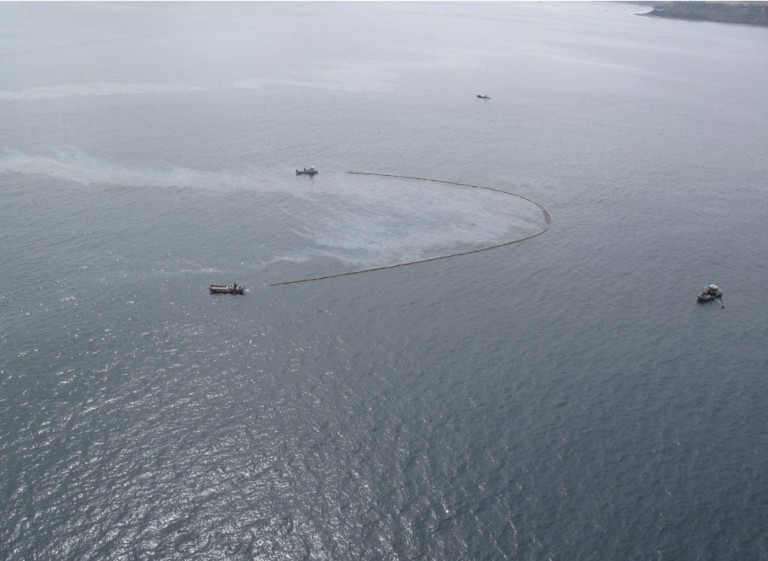
Kyle Roe
Copy Editor
Nonprofit environmental defense group Santa Barbara Channelkeeper hosted a talk last Wed., Feb. 10, to review the response to the Refugio Oil Spill by government agencies, as well as efforts to prevent future spills. Held at the Santa Barbara Museum of Natural History’s Farrand Hall, the talk was the second in an ongoing weekly series titled “After the Spill” that is focused on “how Santa Barbara is moving forward after the Plains All-American Pipeline Spill.”
This week’s talk featured a panel of five speakers who were heavily involved in the recovery process, including Assemblymember Das Williams and Wendy Motta, an employee at the Office of Congresswoman Lois Capps.
Assemblymember Williams provided insight on the regulatory failures that led to the dangerous corrosion of the Plains Line 901 pipeline. According to Williams, oil pipelines can either be labeled as interstate pipelines, meaning they cross state borders and are subject to federal oversight from the Pipeline and Hazardous Materials Safety Administration (PHMSA), or intrastate pipelines, meaning they operate in one state and are subject to oversight from that state.
Despite the strict definitions, companies can opt for federal oversight by simply reporting to PHMSA that their pipeline is “interstate,” which Williams says is like asking, “Do you want to be regulated by the person who never checks your work unless something goes wrong, or do you want to be regulated by the State Fire Marshal that requires you to submit safety information [regularly]?” Currently, there are no penalties or laws against claiming a pipeline that only runs within the state of California is an interstate pipeline.
According to Motta, the pipeline was intended to stretch to Texas when it was built in 1983, but, “there was a lawsuit where the county wanted to have jurisdiction over it, and that was held up in court.” Line 901 runs for 10 miles from Las Flores to Gaviota, where it connects to Line 903 and then for 128 miles to Kern County. Lines 901 and 903 are the only oil pipelines in Santa Barbara County under federal jurisdiction. Motta also revealed that Line 901 underwent an in-line inspection on May 5, 2015, just 11 days before the spill.
The corroded sections of the pipeline have been replaced and fitted with a plastic shrink tube to guard against moisture, which caused the original pipes to become soggy, expand and become vulnerable to corrosive materials like crude oil. On Nov. 12, PHMSA issued a Corrective Action Order instructing Plains to shut down the vast majority of Line 903, stretching from Gaviota to Pentland, Calif., due to “similar corrosion characteristics as Line 901 and a number of the anomalies [having] characteristics consistent with the failure site.” The stretch of Line 903 between Gaviota and Sisquoc was particularly corroded, and the entire line will remain inactive until all crude oil is removed.
Among the areas impacted by the Refugio Oil Spill were beaches included in the University of California, Santa Barbara Natural Reserve System (NRS), particularly Coal Oil Point Reserve. According to the NRS website, the Reserve, which is “known for its breeding population of federally threatened Western snowy plovers,” alerted their staff when they heard about the spill, who “immediately began conducting pre-spill surveys of plover nests, and bought mealworms to feed captive-incubated chicks in case their typical diet of beach hoppers got too contaminated for consumption,” in addition to cleaning affected birds and other marine wildlife. An estimated 195 birds and 106 mammals were killed in the Refugio Oil Spill.
Commander Rom Matthews of the U.S. Coast Guard also called for the recruitment of more first responders in Santa Barbara County through community outreach. “In LA County and Orange County there is five emergency responders for every one Coast Guard person,” he said. “We are resource rich down in LA and Orange County. Up here it gets a little thinner. We have to do a better job of reaching out to you all.”
Matthews said the presence of local first responders is crucial to accessing local knowledge, including current patterns and information about natural tar seeps, and hopes to increase enrollment through area community meetings.
Next week’s talk is titled “After the Spill: Research and Monitoring Impacts from the Spill” and will take place at 6 p.m. on Wed., Feb. 17, in Farrand Hall at the Santa Barbara Museum of Natural History.
















